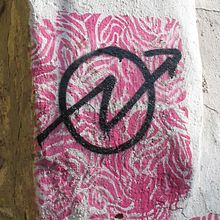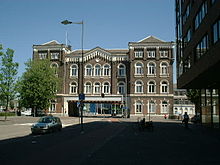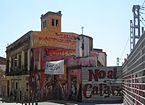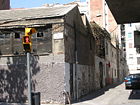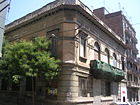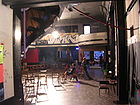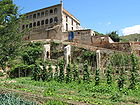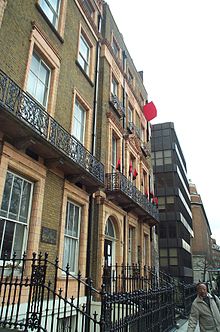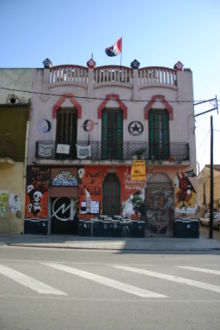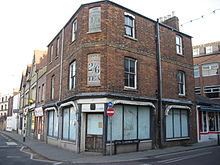- Squatting
-
"Squatter" redirects here. For other uses, see Squat (disambiguation).For the resting position, where the weight of the body is on the feet, see squatting position.
Squatting consists of occupying an abandoned or unoccupied space or building, usually residential,[1] that the squatter does not own, rent or otherwise have permission to use.
Author Robert Neuwirth suggests that there are one billion squatters globally, that is, about one in every seven people on the planet.[2] Yet, according to Kesia Reeve, "squatting is largely absent from policy and academic debate and is rarely conceptualized, as a problem, as a symptom, or as a social or housing movement."[3]
Contents
Overview
In many of the world's poorer countries, there are extensive slums or shanty towns, typically built on the edges of major cities and consisting almost entirely of self-constructed housing built without the landowner's permission. While these settlements may, in time, grow to become both legalised and indistinguishable from normal residential neighbourhoods, they start off as squats with minimal basic infrastructure. Thus, there is no sewage system, drinking water must be bought from vendors or carried from a nearby tap, and if there is electricity, it is stolen from a passing cable.
There is an important distinction to be made between squatting by necessity and squatting as political statement. In this period of global recession and increased housing foreclosures, squatting has become far more prevalent in Western, developed nations.[4] Obviously, in some cases, need-based and politically motivated squatting go hand in hand. According to Dr. Kesia Reeve, who specializes in housing research, "in the context of adverse housing circumstances, limited housing opportunity and frustrated expectations, squatters effectively remove themselves from and defy the norms of traditional channels of housing consumption and tenure power relations, bypassing the 'rules' of welfare provision."[3] In effect, beleaguered citizens living in a welfare state that cannot provide them with adequate resources take action into their own hands and squat.
Dutch sociologist Hans Pruijt separates types of squatters into five distinct categories:[5]
- 1 Deprivation based - ie homeless people squatting for housing need
- 2 An alternative housing strategy - eg people unprepared to wait on municipal lists to be housed take direct action (as discussed in the preceding paragraph)
- 3 Entrepreneurial - eg people breaking buildings to service the need of a community for cheap bars, clubs etc
- 4 Conservational - ie preserving monuments because the authorities have let them decay
- 5 Political - eg activists squatting buildings as protests or to make social centres
In many countries, squatting is in itself a crime; in others, it is only seen as a civil conflict between the owner and the occupants. Property law and the state have traditionally favored the property owner. However, in many cases where squatters had de facto ownership, laws have been changed to legitimize their status. Squatters often claim rights over the spaces they have squatted by virtue of occupation, rather than ownership; in this sense, squatting is similar to (and potentially a necessary condition of) adverse possession, by which a possessor of real property without title may eventually gain legal title to the real property.
Anarchist Colin Ward comments: "Squatting is the oldest mode of tenure in the world, and we are all descended from squatters. This is as true of the Queen [of the United Kingdom] with her 176,000 acres (710 km2) as it is of the 54 percent of householders in Britain who are owner-occupiers. They are all the ultimate recipients of stolen land, for to regard our planet as a commodity offends every conceivable principle of natural rights."[6]
Besides being residences, some squats are used as social centres or host give-away shops, pirate radio stations or cafés. In Spanish-speaking countries, squatters receive several names, such as okupas in Spain, Chile or Argentina (from the verb ocupar meaning "to occupy"), or paracaidistas in Mexico (meaning "paratroopers", because they "parachute" themselves at unoccupied land).
Africa
There are large squatter communities in Kenya, such as Kibera in Nairobi. A BBC News report described it as follows: "The first thing that hits you here is this rich stench of almost 1 million people living in this ditch - in mud huts, with no sewage pipes, no roads, no water, no toilet, in fact, with no services of any kind."[7]
An estimated 1,000 people live in the Grande Hotel Beira in Mozambique.
The Zabbaleen settlement and the City of the Dead are both well-known squatter communities in Cairo.
In South Africa, squatters tend to live in informal settlements or squatter camps on the outskirts of the larger cities, often but not always near townships. In 1994, when Nelson Mandela was elected President, it was estimated that of South Africa's 44 million inhabitants, 7.7 million lived in these settlements.[8] The number has grown rapidly in the post-apartheid era. Many buildings, particularly in the inner city of Johannesburg have also been occupied by squatters. Property owners or government authorities can usually evict squatters after following certain legal procedures including requesting a court order. In Durban, the city council routinely evicts without a court order in defiance of the law, and there has been sustained conflict between the city council and a shack dwellers' movement known as Abahlali baseMjondolo. There has been a number of similar conflicts between shack dwellers, some linked with the Western Cape Anti-Eviction Campaign, and the city council in Cape Town. One of the most high-profile cases was the brutal evictions of squatters in the N2 Gateway homes in the suburb of Delft, where over 20 residents were shot, including a three-year-old child. There have been numerous complaints about the legality of the government's actions and, in particular, whether the ruling of the judge was unfair given his party affiliations and the highly politicized nature of the case.[9] Many of the families are now squatting on Symphony Way, a main road in the township of Delft. The City of Cape Town has been threatening them with eviction since February 2008.
Asia
India
In Mumbai, there are an estimated 10 to 12 million inhabitants, and six million of them are squatters. The squatters live in a variety of ways. Some possess two- or three-story homes built out of brick and concrete which they have inhabited for years. Geeta Nagar is a squatter village based beside the Indian Navy compound at Colaba. Squatter Colony in Malad East has existed since 1962, and now, people living there pay a rent to the city council of 100 rupees a month. Dharavi is a community of one million squatters. The stores and factories situated there are mainly illegal and so are unregulated, but it is suggested that they do over $1 million in business every day.[10]
Other squatters live in shacks, situated literally on a pavement next to the road, with very few possessions.
Activists such as Jockin Arputham are working for better living conditions for slum dwellers.
Malaysia
Many of Malaysia's squatters live on land owned by Keretapi Tanah Melayu as well as at construction sites.
Philippines
Squatting is a major issue in the Philippines, especially in industrialized areas of the Philippines, including Metro Manila. Squatting gained notice after World War II, when people built makeshift houses called Barong-Barong inside abandoned private plots of land.
In the late 20th century, the Philippine government made separate attempts to transfer some squatters to low-cost housing projects, including projects in Tondo (in the former Smokey Mountain landfill), Taguig (BLISS Housing Project), and Rodriguez (formerly Montalban), Rizal.
In the Philippines, a distinction is made between squatters who squat because of poverty and squatters who squat because they want to profit (receive payment in exchange for leaving the real estate property). Squatters who hope to make a profit are called "professional squatters".
Europe
In many European countries, there are squatted houses used as residences and also larger squatted projects where people pursue social and cultural activities. Examples of the latter include an old leper hospital outside Barcelona called Can Masdeu and a former military barracks called Metelkova in Slovenia. Squats can be run on anarchist or communist principles, for example, Fabrika Yfanet, Villa Amalia in Greece, Ernst-Kirchweger-Haus in Austria (has legal status) or Blitz in Norway (has legal status). Young people squat buildings to use as concert venues for alternative types of music such as punk and hardcore. The eviction of one such place, Ungdomshuset, in March 2007 received international news coverage. Others have been legalised.
In Italy, there is Bussana Vecchia, a ghost town in Liguria which was abandoned in 1887 following an earthquake and subsequently squatted in the 1960s. In France, there is Collectif la vieille Valette, a self-supporting squat village which has been active since 1991.
Denmark
Christiania is an independent community of almost 900 people founded in 1971 on the site of an abandoned military zone. In Copenhagen, as in other European cities such as Berlin and Amsterdam, the squatter movement was large in the 1980s. It was a social movement, providing housing and alternative culture. A flashpoint came in 1986 with the Battle of Ryesgade. Another flashpoint came in 2007 when Ungdomshuset was evicted. While not technically a squat until 14 December 2006, it was a social center used by squatters and people involved in alternative culture more generally.
France
Squatting is broadly an economic issue in France, particularly in Paris, one of the costliest cities in Europe. But whereas migrants without papers try not to draw the attention of the police, alternative and artist's squats break the news from the 1980s onwards. In the 1980s, Art-Cloche (from "clochard", i.e. tramp – founded by Jean Starck and Nicolas Pawlowski) promoted "artistic occupation", organising festivals and creating a fake museum.
In the 1990s, a wider movement comes from eastern Europe: young European artists settle in East-Berlin's abandoned buildings after the fall of the Wall. A few years later, back in their own countries, and notably in France, they began to occupy all kinds of places, from state-owned sites ("Lycee Diderot", where 300 artists worked for 2 years in so-called "Pôle Pi", dismantled by police in 1998), to institutional properties (Galerie Matignon, almost next door to Prime Minister's Hotel Matignon, and wealthy art galleries).
Around 2000, the artist's squats movement was exposed in the medias, and quite popular (as they chose to occupy empty public-owned buildings mainly, at a time when middle-class Parisians could not afford sky-rocketing prices for renting a decent flat). "L'électron libre", a gorgeously-ornamented building (in a raving psychedelic style) located in the core of the city (59 rue de Rivoli), and owned by a French Bank, was in 2001 the third most visited place for contemporary art (40,000 visitors a year, according to the French Ministry for Culture). Closed a few years ago, it was bought back by the socialist town council and reopened in 2010. Another famous place (les Frigos) was legalized and integrated into the cultural politics of the town council.
These cases illustrate the quest of most of artist's squat for agreements with buildings owners, be it for a few years ("bail precaire" i.e. "temporary lease"). A handful of mayors in France chose to experiment this form of support to living art (one of the best known is La Belle-de-Mai in Marseille), and Paris is coming to it, cautiously. The move may be too slow: in June 2010, Court ordered the eviction of Paris older artist's squat,[11] a renowned place for close-to-free concerts (5,000 groups in 10 years, from all countries), and where the state-owned Culture TV-channel ARTE itself went to record live sessions: and there was nothing the mayor could do, the tenant being a private investor.
Germany
In the 1970s, squatting in West German cities led to "a self-confident urban counterculture with its own infrastructure of newspapers, self-managed collectives and housing cooperatives, feminist groups, and so on, which was prepared to intervene in local and broader politics".[12] The Autonomen movement protected squats against eviction and participated in radical direct action.
After the German reunification, many buildings were vacated due to the demise of former state-run enterprises and migration to the western parts of Germany, some of which were then occupied by squatters. In Berlin, the now-legalised squats are in desirable areas such as Mitte and Prenzlauer Berg. Before the reunification, squats in Berlin were mostly located in former West Berlin's borough of Kreuzberg. The squats were mainly for residential and social use. Squatting became known by the term instandbesetzen, from instandsetzen ("renovating") and besetzen ("occupying").[13]
Despite being illegal, squats exist in many of the larger cities. Examples are Au in Frankfurt and Hafenstraße and Rote Flora in Hamburg, though the last open squat of Berlin, Brunnenstraße183, was evicted in November 2009.
Squatting can also take place for campaigning purposes, such as the Anatopia project, which protested against a Mercedes-Benz test track.
Greece
Greece has a long tradition of anarchist squats, the oldest one being Villa Amalias and Lelas Karagianni from late 80's. Also squatted in Athens are Patision & Skaramaga, Zaimi, Anw Katw, Pikpa, Strouga and others. An example of a more modern squat is Prapopoulou squat, which is well known internationally.
There are seven anarchist squatted buildings in Thessaloniki, notably Fabrika Yfanet, an 19.000 m2 area and over 100 years old textile factory, other squats are Terra Incognita, Delta, Sxolio, Orfanotrofio etc. There are also squats in Patras, Chania, Volos, Heraklio, Ioannina, Mitilini, Corfu. Also there are a lot of squats in university buildings.[citation needed]
Many anarchist squats in Greece have an abandoned garden nearby which the occupants often re-purpose as a free garden to grow organic vegetables.
Most anarchist or autonomist squats in Greece maintain a blog or website to post their news, and they often also have an internet forum and e-mail address. Community-oriented squats often organize music gigs or movie screenings, usually announced on Athens Indymedia or Kinimatorama.net[14] in addition to the squat's blog. A few squats experiment with DIY renewable energy generation, such as wind turbines, but most of them are depended on the main grid or have no power (there have been attempts by the power and water companies to cut their access to these resources). Sometimes anarchist or autonomist academics or writers of international fame are invited to give talks at squats, and very often free food is served to the community. Usually every squat's blog also lists links to the blogs of most other squats.
Most politically-oriented squats in Greece hold regular (usually weekly) open meetings where everyone is allowed to attend and see how work at the squat is organized and how the responsibilities are shared among the squat's team. Anarchist and autonomist squats in Greece engage with the local community by hosting cultural events, political talks, printing posters and announcements, or going out to the local community's square and holding events there, such as movie screenings, music gigs, talks, or offering free food, books, clothes, or children's toys.
Anarchist and autonomist squats in Greece and people visiting them often face state persecution, including arrests or police attacks, in addition to violent attacks by the far-right.
A steki (Greek for place) is a place very similar to an anarchist or autonomist squat without being really squatted, usually being a small rented apartment or building.
Iceland
Iceland, on the other hand, does not have a long tradition of squatting, but homeless people have been occupying abandoned houses for the same reasons as in other countries. The number of homeless people in Iceland is not high, so it has not received much attention since slums do not exist. The first political squat was done on Vatnsstigur 4 in Reykjavik on the 9th of April 2009, 6 months after a complete economic collapse due to bankers that bought all the banks 4 years earlier. This was done by a group of people with anarchists ideas stating that "capitalism allows banks to own a house and leave them intentionally empty so that they will rot on their own and be replaced with a shopping center, using money that didn't exist and left the debt to the people that many did not participate in the loan-spree advocated by the banks before depression." "We will not tolerate that the rich are getting richer and the society getting less cultural."[15] In 5 days the targeted house was shaped up, a free-store was opened, paper and music publishing had started, and there was support from the neighbours who were excited to get some "life in the street". The house was gutted by between 50-60 riot police officers 5 days later and arrested the 15 squatters after they had barricaded themselves inside and resisted for over 2 hours. People associated with the independent media were also arrested. In the following weeks, the free shop was reopened several times. The first instance of this was on the 6th of May, 2009 in solidarity with the Rozbrat squat in Poland. In July 2009 the house was put on fire.
The second squat used as a social space was founded by a group of graffiti artists that put up an art-exhibition on the 7th of July, 2009.
The third political squat was on Skólavörðustígur also squatted in July 2009. It was an anarchist social center until October 2009 when three young kids putted it on fire.
Few other political but low profile squats have been in Reykjavík since, for example Bræðraborgarstígur 31 which was squatted by few anarchist girls for almost two years.
Italy
In Italy, squatting has no legal basis, but there are many squats used as social centres. The first occupations of abandoned buildings began in 1968 with the left-wing movements Lotta Continua and Potere Operaio. Out of the breakup of these two movements was born Autonomia Operaia, which was composed of a Marxist-Leninist and Maoist wing and also an anarchist and more libertarian one. These squats had Marxist-Leninist (but also Stalinist and Maoist) ideals and come from the left wing of Autonomia. The militants of the Italian armed struggle (the New Red Brigades) were connected to these squats.
The disobedience squats (see Tute Bianche and Ya Basta Association), which are much more common in Italy than the other squats, refuse communist ideology and all its ideals (class war, anti-imperialism, anti-capitalism). They are simply inspired by the Zapatista Army of National Liberation and part of the ideology of taken the thoughts of Antonio Negri. Then there are antagonist squats which are inspired by the Marxism-Leninism of the 1970s: workerism and autonomism. There are also anarchist squats.
The Italian squats are known as C.S.O.A. (Centro Sociale Occupato Autogestito, "self-governing squatter social centers") and include: Leoncavallo, Cantiere, Cox 18, Cascina Torchiera, La Fucina, Vittoria, Transiti 28, Panetteria Occupata, Bottiglieria Occupata and Villa Vegan Squat in Milan, Telos in Saronno, Officina 99, SKA, Insurgencia, Cinema Astra Occupato and Terra Terra in Naples, Askatasuna, El Paso, Gabrio, Murazzi, la Boccia Squat, Mezcal Squat, Asilo Squat and Barocchio Squat in Turin, Brancaleone, Corto Circuito, Forte Prenestino, La Strada, Acrobax, Spartaco, Torre Maura, Horus, L38 Laurentino Squat, Macchia Rossa and Villaggio Globale in Rome, Buridda, Pinelli, Terra Di Nessuno, Aut Aut 357 and Zapata in Genoa, Rivolta in Mestre, Gramigna and Pedro in Padua, La Chimica in Verona, Bruno in Trento, Dordoni in Cremona, Magazzino 47 in Brescia, Pacì Paciana in Bergamo, Barattolo in Pavia, Firenze Sud in Florence, Experia and Auro in Catania, Ex-Karcere in Palermo, Ex-Mattatoio in Perugia, Mario Lupo in Parma, la Scintilla in Modena, Mezza Canaja in Senigallia, Kontatto in Ancona, TNT in Jesi, Godzilla in Livorno, Rebeldia and Newroz in Pisa, Teatro Polivalente, Lazzaretto, XM24, Livello 57 and Crash in Bologna, Cartella in Reggio Calabria, Rialzo in Cosenza, Fiumara in Catanzaro, Cloro Rosso in Taranto and many others.
Many famous Italian Oi!, ska, hardcore punk and rock bands, such as Los Fastidios, Klasse Kriminale, Banda Bassotti, Negazione, Wretched, Raw Power, and Cripple Bastards tour in the areas of these social centers. Recently, several far-right squats have also emerged, the best known being CasaPound, with many social centers all around Italy.
Moldova
Squatting in Moldova is pretty new, as it started with Centro 73 in Chişinău in September 2010. This project is working and starts to be know in medias.[16] A second project of squat in Chişinău in the old Turkish embassy (57, Alexei Mateevici street), called Ada Kaleh, was evicted by police in November 2010.
Netherlands
Banned
On June 1, 2010, the squatting ban was accepted by both houses of Parliament. Squatting in the Netherlands became illegal and punishable when a decree was sent out that the law would be enforced from the first of October.[17] In protest, squatters in Amsterdam had occupied a former fire department the week before the law began (returning it to the owners control on 30 September) and a riot occurred on 1 October when the police blocked a protest and led a horse charge upon it.[18] In Nijmegen (on 2 October), there was also a riot.[19][20]
History
In the past a building could be used legally by someone who needed to squat if it was empty and not in use for twelve months, and the owner had no pressing need to use it (such as a rental contract starting in the next month). The only illegal aspect was forcing an entry, if that was necessary. When a building was squatted, it was normal to send the owner a letter and to invite the police to inspect the squat. The police checked whether the place was indeed lived in by the squatter. In legal terms, this means there must be a bed, a chair, a table and a working lock on the door which the squatter can open and close.
In cities, there was often a kraakspreekuur (squatters' consultation hour), at which people planning to squat could get advice from experienced squatters. In Amsterdam, where the squatting community is still large, there are four kraakspreekuur sessions in different areas of the city, and so-called "wild" squatting (squatting a building without the help of the local group) is not encouraged.[21] Dutch squatters use the term krakers to refer to people who squat houses with the aim of living in them (as opposed to people who break into buildings for the purpose of vandalism or theft).[13]
There are still many residential squats in Dutch cities. There are also some squats in the countryside such as a squatted village called Ruigoord near Amsterdam and Fort Pannerden near Nijmegen. Fort Pannerden (a military fort built in 1869) was evicted on November 8, 2006, by a massive police operation which used military machinery and cost one million euros.[22] The squatters then re-squatted the fort on November 26 and have since made a deal with the local council which owns the fort.[23][24] The deal states that the squatters will receive a large piece of land near the fort to start a community in the rural area in between the city of Nijmegen and Arnhem. In exchange, the fort was handed over to local authorities, who will turn it into a museum, with help provided by the squatters that used to live in Fort Pannerden.
In the past, squats sometimes went through a process of legalisation. This is the case with the Poortgebouw in Rotterdam, which was squatted in 1980. In 1982, the inhabitants agreed to pay rent to the city council. The oRKZ (Oude Rooms-Katholieke Ziekenhuis) in Groningen, squatted in 1979, is an old Roman Catholic hospital, which was declared legal in the 1980s.
Well-known squats include the OT301, Vrankrijk and the Binnenpret in Amsterdam, Anarres in Dordrecht, Het Slaakhuis in Rotterdam and the Landbouwbelang and Villa Vendex in Maastricht. De Blauwe Aanslag in The Hague was evicted in 2003.
Squatting gained a legal basis in the Netherlands in 1971, when the Supreme Court ruled that the concept of domestic peace (huisvrede) (which means a house cannot be entered without the permission of the current user) also applied to squatters. Since then, the owner of the building must take the squatters to court (or take illegal action) in order to evict them. A law was passed in 1994 which made it illegal to squat a building which was empty for less than one year.[25]
There were several moves to ban squatting in the past. In 1978, the Council of Churches launched a protest which scotched the idea. In June 2006, two ministers from the Dutch government (Sybilla Dekker and Piet Hein Donner) proposed a plan to make squatting illegal.[26] Other ministers, such as Alexander Pechtold, were not in favor of this plan. Representatives of the four largest Dutch cities wrote a letter stating that it would not be in their interest to ban squatting.[27] Squatters nationwide made banners and hung them on their squats in protest.[28]
On October 1, 2010, squatting was finally outlawed in The Netherlands after the Squatting Ban Bill was passed into law by both houses of Parliament. On October 28, 2011, the Supreme Court of the Netherlands decided that the legally forced end of squatting can only occur after an intervention of a judge.
Spain
Squatting of empty lots with shanty towns became popular in Spain in the 1960s and 1970s as a result of the shortage of urban accommodation during the rural exodus. Gradually it was substituted by high-rise blocks (often built quickly and poorly). It was revived in the mid-1980s during the La Movida Madrileña, under the name of the okupa (an unofficial spelling applied to ocupación) movement, when thousands of illegal squatted buildings were legalized. Influenced by the British Levellers, the movement's popularity rose again during the 1990s, once more due to a housing crisis, this time related to the 1992 Summer Olympics and the concomitant urban regeneration. Property speculation and house price inflation continue to catalyze okupa activism.[29]
Related to the anarchist movement, okupas support the ideal of Autogestion and create social centers, such as Patio Maravillas in Madrid, which carry out various grassroots activities. The okupa movement represents a highly politicized form of squatting, so much so that participants often claim they live in squats as a form of political protest first and foremost.[30] The movement is involved in various other social struggles, including the alter-globalization movement. In 1996, during José María Aznar's presidency, the first specific legislation against squatting was passed and became the prelude to many squat evictions. In the barrio of Lavapiés in Madrid, the Eskalera Karakola was a feminist self-managed squat, which was active from 1996 to 2005 and participated in the nextGENDERation network.[31] Other examples are the Escuela Popular de Prosperidad (La Prospe) o Minuesa.
As of 2007, there were approximately 200 occupied houses in Barcelona. At least 45 of these, as Infousurpa, a collective event calendar, mentions, are used as social and cultural centers—so- called "open houses".[32] A number of popular rock groups have come out of this kind of venue, such as Sin Dios, Extremoduro, Kolumna Durruti, Refugio and Platero y Tu in Madrid and Ojos de Brujo and Gadjo in Barcelona.
The Basque Country is another area where a high number of houses are occupied. There are at least 46 squats, or gaztetxes ("youth's houses" in the Basque language). During the 1980s, a house was occupied by squatters in almost every town, and the booming punk movement used them to organize concert tours and expositions. During the last 10 years, at least 15 gaztetxes have closed down, often after protests and clashes with the police.[33] The best known gaztetxe currently is from Gasteiz. Squatting has always been related with the Basque independence movement. In the French Basque Country, there are at least five other squat houses.
Chabolismo (shanty towns)
Parallelly there has been a not-ideologized current of shanty towns around big cities. Initially settled by sedentarized Gitanos and Mercheros, they became known after the 1980s as selling points for heroin and other drugs. As the Spanish nomads were transferred to public housing, the shanty towns became inhabited by poor immigrants, including Moroccans and Romanian Romas. The Cañada Real Galiana[34] [35] [36] [37] is an example. It is part of the cañada network of glens, used since the Reconquista by the Mesta organization of sheep-owners for cattle transportation. As such it is public domain and cannot be subjected to other incompatible uses. However a section near Madrid has been squatted, becoming a linear city of about 40,000 people and 15 km in length. The status of the neighborhoods varies along the way. Some areas are drug markets, others are settled by Spanish workers residing there since 20 years ago, and others have families of recently arrived immigrants.
-
Can Masdeu, Barcelona-Collserola
Switzerland
There are squats in the Swiss cities of Bern, Geneva, Winterthur, Lausanne, Basel, Biel/Bienne, Zürich and Lugano.
The RHINO ("Retour des Habitants dans les Immeubles Non-Occupés"; in English, "Return of Inhabitants to Non-Occupied Buildings") was a 19-year-long squat in Geneva. It occupied two buildings on the Boulevard des Philosophes, a few blocks away from the main campus of the University of Geneva. The RHINO organisation often faced legal troubles, and Geneva police evicted the inhabitants on July 23, 2007.[38]
United Kingdom
England
Main article: Squatting in EnglandIn England, squatting has a long historical tradition. The BBC states that squatting was "a big issue in the Peasants' Revolt of 1381 and again for the Diggers in the 17th Century [who] were peasants who cultivated waste and common land, claiming it as their rightful due" and that squatting was a necessity after the Second World War when so many were homeless.[39] The BBC also reported in 2011 that the British government estimated that there were "20,000 squatters in the UK" and "650,000 empty properties".[39]
In March 2011, Mike Weatherley, Conservative MP for Hove, proposed an Early Day Motion calling for the criminalisation of squatting.[40] His campaign was backed by a series of articles in the Daily Telegraph in which Kenneth Clarke (the Secretary of Justice) and Grant Shapps (Minister of Housing) were reported to be backing the move.[41][42][43]
The Government then opened a consultation entitled 'Options for dealing with squatters' on July 31 2011, which ran until October 5. It was "aimed at anyone affected by squatters or has experience of using the current law or procedures to get them evicted." [44] The pro-squatting campaign group SQUASH stated that there were "2,217 responses and over 90% of responses argued against taking any action on squatting." [45] Kenneth Clarke then announced an amendment to the Legal Aid, Sentencing and Punishment of Offenders Bill which would criminalise squatting in residential buildings.[46]
Scotland
Squatting is a criminal offence in Scotland, punishable by a fine or even imprisonment. The owner or lawful occupier of the property has the right to evict squatters without notice or applying to the court for an eviction order, although when evicting, they cannot do anything that would break the law, for example, use violence.[47]
Wales
In 16th- and 17th-century Wales, an expansion in population as well as taxation policy led to a move of people into the Welsh countryside, where they squatted on common land. These squatters built their own property under the assumption of a fictional piece of folklore, leading to the developments of small holdings around a Tŷ unnos, or "house in a night". In 2010, a representative of the UK Bailiff Company claimed that the number of people squatting in Wales was at its highest for 40 years.[48]
North America
Mexico
In Mexico, squatters are known as paracaidistas (that is, "paratroopers", because they "drop" themselves mostly at unoccupied lands), and it is a common practice in large cities. Since the most valuable real property is located near the downtowns of the cities, the paracaidistas usually establish slums at unoccupied lands at the outskirts of the cities. Since Mexican laws establish that an individual may take legal possession of a property after five to twenty years of peaceful occupation, many paracaidistas establish themselves with the hope that the legal owner will not discover them and expel them before five years. Large extensions of many Mexican cities were established originally as squats (for example, Nezahualcoyotl, in Mexico City). Squatting has also been used with political purposes, with more of one political parties promising existing squatters to legalize their situation if they support their candidates in the elections; or sometimes with the purpose to serve as human obstacles for another party, occupying the space that was going to be used for constructing public buildings or parks.
United States
Main article: Squatting in the United StatesIn the United States, squatting laws vary from state to state and city to city. For the most part, it is rarely tolerated to any degree for long, particularly in cities.[49] There have been a few exceptions, notably in 2002 when the New York City administration agreed to turn over eleven squatted buildings in the Lower East Side to an established non-profit group, on the condition that the apartments would later be turned over to the tenants as low-income housing cooperatives.[50]
Squatters can be young people living in punk houses, low-income or homeless people, street gang members, or artists. Recently there have been increasing numbers of people squatting foreclosed homes.[51][52] There are also reports of people resquatting their own foreclosed homes.[53]
South America
Around many South American cities there are shanty towns. Sometimes, the authorities tear the houses down, but often, the squatters simply rebuild again. The houses are built out of whatever material can be scavenged from the local area or bought cheaply. As time goes by, the squatters start to form communities and become more established. The houses are rebuilt piece by piece with more durable materials. In some cases, a deal is reached with the authorities and connections for sewage, drinking water, cable television and electricity are made.
In Peru, the name given to the squatter settlements is pueblos jóvenes. In Colombia they are called invasiones (as in "invading a property", as squatting can be related to a building or an empty lot), in Venezuela they are known as barrios, in Argentina the term used is villa miseria, in Chile they are called Tomas, and in Uruguay, cantegriles.
Brazil
In Brazil, these squatter communities are called favelas, and a famous example is Rocinha in Rio de Janeiro, estimated to be home of 100,000 people. Favelas are home to the extremely poor of Brazil and usually lack much infrastructure and public services, but in some cases, already have reached the structure needed for a city. They are equivalent to slums or shanty towns. There are 25 million people living in favelas all over Brazil.[2]
In São Paulo the largest favela is Heliópolis, with over 100,000 inhabitants. However, its occupied area has been officially recognized as a regular neighborhood of the city. There are also a number of squatter buildings in the inner city, the most famous of which was a 22-story building called Prestes Maia, whose inhabitants were finally evicted by the police in 2007 after a long conflict with the city administration.
There are also rural squatter movements in Brazil, such as the Landless Workers' Movement, which has an estimated 1.5 million members.
Oceania
Australia
In the 19th century, a squatter was a person who occupied a large tract of Crown land in order to graze livestock. At first, this was done illegally, and later under license. From the 1820s they were part of the establishment, hence the term Squattocracy. This type of squatting is covered in greater detail at Squatting (pastoral).
In more recent times, there have been squats in the major cities. It would be possible for squatters to be charged with criminal trespass under the Enclosed Lands Protection Act, but mainly, squatters are simply evicted when they are discovered. As in the United Kingdom, there is the law of adverse possession, but it is seldom used.
Sydney
In Sydney, streets of terraced houses in areas such as the Rocks and Potts Point were squatted to prevent their demolition in the 1970s. The Glebe estate in Glebe, New South Wales was squatted in the 1960s and 1970s, and had an extensive influx of squatters in the 1980s. Also during the 1970s and 1980s, extensive parts of Woolloomooloo and Darlinghurst were also squatted, along corridors of houses bought to make way for new road works. Examples of these include "The Compound" in Darlinghurst and along Palmer Street in Woolloomooloo. Punks, political activists, musicians and artists also started squatting in "The Gunnery", a former Navy warehouse and training facility, in Woolloomooloo, during the early-to-mid 1980s. This squat, a large warehouse with several unusual spaces able to be used as theatres or other venues (thanks to its former use by the Navy) became a critical site for the development of arts and music in Sydney in the mid to late 1980s, with independent musical and art events being held there regularly. It is now an arts centre.,[54]
The artists squatting empty buildings on Broadway owned by South Sydney City Council were evicted in 2001, a few months after the 2000 Olympics.[55]
The Midnight Star was a squatted theatre used as a social centre, hosting music events, a cafe, a library, a free internet space and a Food Not Bombs kitchen. It was evicted in December 2002 following its use as a convergence centre for protests against the November World Trade Organisation talks.[56]
In 2003, a legal squat was organised for ten people who moved onto the site of an old incinerator at Green Square.[57]
A five-year-old squat was peacefully evicted in March 2008, when an office block in Balmain was demolished to make way for a park. The council voted to allow the squatters to stay in the building, which they called Iceland, until the plans for demolition were in place. One of the squatters said, "About 20 people have lived here over the years and it's been a place for band rehearsals, art projects, people practising dance routines, bike workshops. Squatting gives you a chance to think about things other than how you are going to pay the rent and ways to contribute to the world."[58]
The Squatfest film festival began in the Broadway squats in 2001. It is both a celebration of squatting and a protest against the corporate capitalism of the Tropfest film festival in Sydney. Every year, a site is occupied and films screened. The location is announced hours before screening begins.[59]
There were estimated to be more than 120,000 unoccupied houses in Sydney in 2011.[60]
Melbourne
Melbourne squats are usually located in the inner suburbs, like Footscray, St. Kilda and Coburg. They tend to be houses that are waiting for demolition. A well-known squat in Carlton was organised by international students in 2008. A Squatter's Handbook was produced by activists in 1993, 2001 and 2010.[61]
Brisbane
From 1995 to 2009 in Brisbane the capital of Queensland, a number of old buildings and dilapidated back alleys were used as squats within the vicinity of Brisbane City's Queen Street Mall. There are roughly 30-60 long-term homeless persons in the Brisbane CBD at any one time, who typically use squats as a means of shelter. Irregular intervals can bring 30-60+ short term displaced people.
Social centers
In Europe, it is common for buildings to be squatted to be used as social centres. Cafés, bars, libraries, free shops, swaps shops and gyms have all been created, with many squats also holding parties and concerts. Social centers are often a combination of many things that happen in one space with the aim of creating a space for people to meet in a non-commercial setting, whether it be for a party, political workshop, to see a film, have a drink or have breakfast. There are many squatted social centers around the world, but they exist mainly in countries where squatting is legal. Examples include Ernst-Kirchweger-Haus in Austria, the RampART Social Centre in England, OT301 in the Netherlands and Ungdomshuset in Denmark (evicted on March 1, 2007 and demolished four days later).
Notable and well known examples
Country Notable Squats Austria - Ernst-Kirchweger-Haus (EKH), Vienna
Brazil Canada Croatia Czech Republic - Villa Milada, Prague (evicted in 2009)
Denmark Finland - Satama, Helsinki
France - 40-44, avenue Jean-Moulin, Paris (evicted the 20th of March 1981)
- 102, Grenoble
- 59 Rivoli, Paris
- Art-Cloche, Paris (evicted the 27th of June 1988)
- CAES, Ris-Orangis
- La Clinique, Montreuil (evicted the 8th of July 2009)
- Espace autogéré des Tanneries, Dijon
- Hôpital éphémère, Paris (evicted in 1995)
- Le Château Pirate, Paris (evicted the 1st of June 2011)
- Les Frigos, Paris
- La Miroiterie, Paris
- La Pelle-Tueuse, Grenoble (evicted the 3rd of June 2010)
- Le Pigeonnier, Nice
- Le Théâtre de Verre, Paris
Germany - Anatopia, Papenburg
- Au, Frankfurt
- Brunnenstraße183, Berlin (evicted November 24, 2009)
- Hafenstraße, Hamburg
- Rote Flora, Hamburg
- Topf and Sons factory, Erfurt
- Kunsthaus Tacheles, Berlin
Greece - Fabrika Yfanet, Thessaloniki
- Villa Amalia, Athens
- Matsagou, Volos
- Rosa Nera, Chania
- Antiviosi, Ioannina
Italy - Lsoa Buridda, Genova
- Csoa Terra di Nessuno, Genova
- CS Leoncavallo, Milan
- Officina 99, Naples
- Bussana Vecchia, Liguria
- Social centers category on Italian Wikipedia
Lithuania Moldova Mozambique Netherlands - ASCII, Amsterdam
- OT301, Amsterdam
- Ruigoord, Amsterdam
- Huize Spoorloos, Emmen
- HCZ, Eindhoven
- De Blauwe Aanslag, The Hague
- Fort Pannerden, Pannerden
- Poortgebouw, Rotterdam
- Het Slaakhuis, Rotterdam
Norway Philippines Poland - Rozbrat, Poznań
- Krzyk, Gliwice
- Elektromadonna, Częstochowa
Slovenia - Sokolski dom, Novo mesto (former cultural centre)
- Metelkova, Ljubljana (claimed free state in former army garrison)
- Tovarna Rog, Ljubljana (abandoned bike factory)
Slovakia - Palac Sofia, Zilina
South Africa - Kennedy Road, Durban
- Joe Slovo Informal Settlement, Cape Town
- Symphony Way Pavement Dwellers, Cape Town
Spain Switzerland United Kingdom - The Oubliette Arthouse, London
- Eel Pie Island, London
- RampART Social Centre, London
- Spike Surplus Scheme, London
- Argyle Street Squat, Norwich
- St Agnes Place, London
- Medina House, Hove
- Kew Bridge Eco Village, London
United States - ABC No Rio, New York City,
- C-Squat, New York City
- People's Park, Berkeley
- Zzyzx Mineral Springs and Health Spa
- 92 Bird Avenue, Buffalo, NY
- Slab City, Niland, CA
- lowercase collective, Chicago, IL
Well-known squatters
- Black Donnellys, James Donnelly squatted on the southeastern quarter of Lot 18, Concession 6 (also known as the Roman Line), Biddulph Township, Canada West.[citation needed]
- Robert Harrill, known as "The Fort Fisher Hermit", set up a simple home in an abandoned World War II era bunker near the Cape Fear River, NC, along a salt marsh.
- Randy Quaid, arrested in 2010 for squatting in a home he had previously owned[62]
- Curtis Howe Springer, found guilty of the charge of squatting on federal land[63]
- Richard Stallman, American software freedom activist, hacker, and software developer, called himself a squatter on campus.[64]
- Robert Louis Stevenson, Scottish novelist, poet, essayist and travel writer[65]
- Joe Strummer, the co-founder, lyricist, rhythm guitarist and lead singer of the English punk rock band The Clash[66]
- Monckton Synnot, prominent squatter in Victoria, Australia[citation needed]
- Stza, fronted several skacore bands in the New York City area, the best known being Choking Victim and Leftöver Crack[67]
- Sid Vicious, English musician best known as the former bassist of the influential punk rock group Sex Pistols[68]
- Gerrard Winstanley, English Protestant religious reformer and political activist during the Protectorate of Oliver Cromwell[69]
- S'bu Zikode, elected head of the South African shackdwellers' movement Abahlali baseMjondolo[70]
Urban homesteading
Urban homesteading is a form of self-help housing where abandoned private properties in urban areas are taken over by the building’s usually poor residents.
Sometimes this takes the form of squatting, which is not legal under many jurisdictions. Urban homesteading - in which residents rehabilitate the apartments through their own labor - may depart from squatting in some ways, especially philosophically.[71]
While both groups may work initially with no permits, architectural plans or help from the government, self-help housing aims to manage the buildings cooperatively, and residents may work collaboratively with a non-profit organization or city government to legally obtain ownership of the building.[71]
In some cases, urban homesteading is an organic phenomenon that evolves as a grassroots strategy of residents for dealing with a lack of affordable housing, or a sizable existence of abandoned, depressed, neglected or foreclosed housing stock. Some cities have used it as a solution to creating affordable housing.[72]
See also
- Abahlali baseMjondolo
- Adverse possession
- Claim club
- Gecekondu Squatting public land in Turkey.
- Homeless Workers' Movement
- Inclusionary zoning
- Movimento dos Trabalhadores Sem Teto (MTST)
- Squatting (pastoral), in Australia, often a large landholder, as in Waltzing Matilda.
- Western Cape Anti-Eviction Campaign
References
- ^ Roberts, Chris (2006), Heavy Words Lightly Thrown: The Reason Behind Rhyme, Thorndike Press, ISBN 0786285176
- ^ a b Neuwirth, R. (2004), Shadow Cities: A Billion Squatters, A New Urban World, Routledge, ISBN 0415933196
- ^ a b Reeve, Kesia, "Squatting Since 1945: The enduring relevance of material need", in Somerville, Peter; Sprigings, Nigel, Housing and Social Policy, London: Routledge, pp. 197–216, ISBN 0415283663
- ^ Peñalver, Eduardo M. (March 25, 2009). "Homesteaders in the Hood". Slate Magazine. http://www.slate.com/id/2214544/.
- ^ Pruijt, Hans, Squatting in Europe - English version of Pruijt, H., 2004, "Okupar en Europa", in: Miguel Martínez Lopez and Ramón Adell (eds) ¿Dónde están las llaves? El movimiento okupa: prácticas y contextos sociales, Madrid, La Catarata, 35-60, http://home.kpn.nl/Kiebeler/homepage%20Hans/Squatting%20in%20Europe.htm, retrieved 2011-05-24
- ^ Ed. Wates and Wolmar (1980) Squatting: The Real Story (Bay Leaf Books) ISBN 0-9507259-0-0
- ^ Living amidst the rubbish of Kenya's slum
- ^ Informal settlements in South Africa
- ^ Western Cape Housing Crisis: Writings on Joe Slovo and Delft
- ^ Pages 110-114 Neuwirth, R (2004) Shadow Cities: A Billion Squatters, A New Urban World, Routledge ISBN 0-415-93319-6
- ^ In Paris, Art Fills the Void
- ^ Mayer M The Career of Urban Social Movements in West Germany in eds Fisher R and Kling J Urban Affairs Annual Review volume 41 London (1993)
- ^ a b Pruijt H Squatting in Europe - English version of Pruijt, H., 2004, Okupar en Europa, in Miguel Martínez Lopez and Ramón Adell (eds) ¿Dónde están las llaves? El movimiento okupa: prácticas y contextos sociales, Madrid, La Catarata, 35-60 Available online
- ^ kinimatorama.net
- ^ hustaka.org
- ^ "multimedia | centro 73 chişinău". Centro 73. http://centro73.wordpress.com/infomedia/. Retrieved 2010-11-27.
- ^ "Eerste Kamer neemt antikraakwet aan - Binnenland - de Volkskrant". Volkskrant.nl. http://www.volkskrant.nl/binnenland/article1384686.ece/Eerste_Kamer_neemt_antikraakwet_aan. Retrieved 2010-10-02.
- ^ Indymedia Netherlands Squat Ban Riot
- ^ whatever.squat.net
- ^ “” (2010-10-02). "Squatters demo in Nijmegen". YouTube. http://www.youtube.com/watch?v=w6RGu2ufeKU. Retrieved 2010-11-25.
- ^ Wiegand E. (2004) Trespass at Will: Squatting as Direct Action, Human Right & Justified Theft (LiP Magazine)
- ^ Politie hervat ontruiming Fort Pannerden
- ^ Fort Pannerden voorlopig niet ontruimd
- ^ Fort Pannerden blijft voorlopig
- ^ Pruijt, Hans (2003), "Is the institutionalization of urban movements inevitable? A comparison of the opportunities for sustained squatting in New York City and Amsterdam", International Journal of Urban and Regional Research 27 (1): 133–157, doi:10.1111/1468-2427.00436.
- ^ Kraken wordt strafbaar
- ^ Grote steden tegen verbod op kraken
- ^ Landelijke spandoekenaktie kraakverbod
- ^ The 'success' of Barcelona
- ^ CASA Participants 2005
- ^ nextGENDERation network
- ^ Infousurpa – Butlleti setmanal de contr@informació des del 1996. Nr. 486, 11 to 17 July 2007 (collective, weekly updated event calendar of 45 occupied houses in Barcelona; hanging out in occupied houses)
- ^ Desalojo del gaztetxe Euskal Jai en Iruña on YouTube
- ^ ¿Ilegales para siempre?., Javier Lafuente, El País, 19 March 2008.
- ^ De camino de ovejas a foco de marginalidad, José Luis Martín, El Mundo, 3 June 2004
- ^ La Cañada Real, foco de delincuencia y venta de droga, El Mundo, 18/10/2007.
- ^ Unos 200 vecinos de la Cañada Real Galiana protestan contra el desalojo de ayer con una marcha por la A-3., Público, 19/10/2007.
- ^ Eviction of squatters from SwissInfo
- ^ a b Squatters: Who are they and why do they squat?, BBC
- ^ Early day motion 1545
- ^ Howie, Michael (2011-03-19), Squatting to be made illegal, vows Clarke, Daily Telegraph, http://www.telegraph.co.uk/news/uknews/law-and-order/8388795/Squatting-to-be-made-illegal-vows-Clarke.html, retrieved 2011-05-24
- ^ Romero, Roberta (2011-05-24), Coalition to make squatting a criminal offence, Daily Telegraph, http://www.telegraph.co.uk/news/politics/8392571/Coalition-to-make-squatting-a-criminal-offence.html, retrieved 2011-05-24
- ^ Hutchison, Peter (22011-03-18), Squatters: how the law will change, Daily Telegraph, http://www.telegraph.co.uk/news/uknews/law-and-order/8389196/Squatters-how-the-law-will-change.html, retrieved 2011-05-24
- ^ 'Options for dealing with squatters'
- ^ 'Campaign lobbies against rush to criminalise'
- ^ 'Legal Aid, Sentencing and Punishment of Offenders Bill'
- ^ Squatting
- ^ Rise in squatters puts more Welsh homeowners at risk of huge eviction bills
- ^ Romero, Roberta (2008-09-26), City moves to evict homeless campers, KING 5 TV, http://www.king5.com/topstories/stories/NW_092608WAB_nickelsville_eviction_LJ.b3b65546.html, retrieved 2008-09-26
- ^ Ferguson, Sarah (August 27), "Better Homes and Squatters: New York's Outlaw Homesteaders Earn the Right to Stay", The Village Voice, http://www.villagevoice.com/2002-08-27/news/better-homes-and-squatters/1
- ^ Netter, Sarah (2010-08-23), "Anti-Government Sovereign Citizens Taking Foreclosed Homes Using Phony Deeds, Authorities Say", ABC NEWS, http://abcnews.go.com/US/georgia-battling-sovereign-citizens-squatting-foreclosed-homes/story?id=11445382
- ^ Bernstein, Maxine (August 27), "A homeowner startled to find squatter living in the Portland house he bought out of foreclosure", The Oregonian, http://www.oregonlive.com/portland/index.ssf/2011/04/portland_man_startled_to_find.html
- ^ Roberts, Chris (2011-05-20), "After Foreclosure, Woman Breaks Back into, Squats", NBC, http://www.nbcbayarea.com/news/local/After-Foreclosure-Woman-Breaks-Back-into-Squats-In-Empty-Bank-Owned-Home-122332484.html
- ^ "State Library of NSW Search - Manuscripts, Oral History, and Pictures Catalogue". Acms.sl.nsw.gov.au. http://acms.sl.nsw.gov.au/search/subjectsearch.aspx?authority=place&id=38158. Retrieved 2010-11-25.
- ^ SquatSpace History - Broadway Squats
- ^ SquatSpace History - Midnight Star
- ^ "Home for Sydney squatters with fire in its belly". Sydney Morning Herald. October 7, 2003. http://www.smh.com.au/articles/2003/1/06/1065292527665.html?from=storyrhs.
- ^ Creagh, Sunanda Squatters out as bulldozer start engines in the Sydney Morning Herald May 5, 2008
- ^ "squatfest". SquatSpace. 2010-02-21. http://www.squatspace.com/squatfest/. Retrieved 2010-10-02.
- ^ The art of setting up home for diddly-squat 21-5-2011
- ^ Melb Squatters Guide
- ^ Dobuzinskis, Alex (2010-09-19), Randy Quaid arrested for squatting in old home, Reuters, http://www.reuters.com/article/2010/09/19/us-quaids-idUSTRE68I2KX20100919, retrieved 2011-05-24
- ^ Eckler, Ross (1996), "Zzyzx", Word Ways: The Journal of Recreational Linguistics (Word Ways: The Journal of Recreational Linguistics), ISSN 0043-7980, archived from the original on 2007-19-27, http://web.archive.org/web/*/http://wordways.com/zzyzx.htm, retrieved 2008-11-02
- ^ Lerner, Reuven M (1990-07-18), Stallman wins $240,000 in MacArthur award, The Tech, http://tech.mit.edu/V110/N30/rms.30n.html, retrieved 2006-11-26
- ^ The Robert Louis Stevenson Silverado Museum
- ^ Squat 'n' roll hero
- ^ A not so brief history of No Commercial Value, Chocking Victim, & Leftover Crack (In the words of Stza himself)
- ^ The Dope on The Sex Pistols
- ^ Gerard Winstanley: 17th Century Communist at Kingston (Christopher Hill, 1996)
- ^ City: 'Squatters and the cities of tomorrow'
- ^ a b Bearak, Barry (May/June, 1994), "Turf Wars", National Housing Institute: Issue 75, http://www.nhi.org/online/issues/75/turfwars.html
- ^ Penalver, Eduardo (March 25, 2009), "Homesteaders in the Hood: Squatters are multiplying in the recession - what should cities do?", Slate.com, http://www.slate.com/id/2214544/
Further reading
- 949 Market (2002) - a zine by a group of people who squatted an abandoned pool hall in a very public way and created a community center in San Francisco.
- Corr, A. (1999) No Trespassing! Squatting, Rent Strikes and Land Struggles Worldwide South End Press ISBN 0-89608-595-3
- Cracking The Movement (1994) - Amsterdam squatter history and the movement's relation to the media. Also available online
- Cracking The System (2008) - A zine about squats and social centres in Europe inspired by the april2008 initiative. Also available online
- Katsiaficas, G. (1999) The Subversion of Politics: European Autonomous Social Movements and the Decolonization of Everyday Life Humanity Books ISBN 1-57392-441-5 Also available online
- Waterhouse, Richard (2005). The Vision Splendid: A Social and Cultural History of Rural Australia, Fremantle, Curtain University Books
- War In The Neighborhood – a Graphic Novel about squatting on New York City's Lower East Side in the 1980s by World War 3 Illustrated artist and editor Seth Tobocman published by Autonomedia
External links
- Interview with director Tino Buchholz about his documentary 'Creativity and the Capitalist City' - Squatting in Amsterdam, 04/10/11 by ar2com
- Special issue of Mute Magazine on global slums
- Squat.net - Intersquat website
- Squattercity Blog Blog by writer Robert Neuwirth, who lived in squatter communities across the developing world
- Squatter's Handbook England 13th Edition
- Wasteland (UK) - Documentary about squatting by Will Wright
- What's this place? (2008) - A booklet with stories from radical social centres in the United Kingdom and Ireland.
Categories:
Wikimedia Foundation. 2010.




